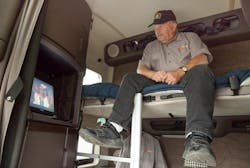Josh Simpson is a Brooklyn-based photographer who loves to go behind the scenes, taking shots of people's spaces that few outsiders get to see. Recently, he was given an assignment by VICE to shoot the world of truck drivers, and you can see the results in Photos from Inside the Cabs of Long-Distance Truckers.
Check out Fleet Owner's exclusive gallery from Simpson's project.
In the gallery introduction, Simpson writes: "The 18-wheeler is a symbol of American freedom and blue-collar pride if ever there was one. But beyond a wary pass in the left hand lane, most of us don't give much thought to the giant Peterbilts and Macks barreling down the highway 24 hours a day. Recently, however, I found myself thinking more about these ubiquitous monsters. Who are the people driving them, and what does it look like inside the cab?"
We spoke with Simpson, and here are edited excerpts from that conversation.
What attracted you to photograph truckers' cabins?
"I love just shooting back spaces, hidden rooms and mom-and-pop areas as opposed to chain stores or restaurants that you don't normally get to see. I'm always curious about what different people's lives are like and seeing the day-to-day parts even if it’s messy. Often times, people are suspect if you're interested, but if you have a camera that gives you an excuse. It's important to show these spaces and to give that part of different people's lifestyles credit as something that's valid, interesting and potentially useful."
Where did you find truckers to shoot?
"I visited two truck stops. The first was just outside of New York City [Vince Lombardi rest area on the New Jersey Turnpike], and it was enormous and intimidating. People were pretty suspect, so they just weren't interested. I think when truckers get close to the city, they get a little suspicious of people. Lombardi isn't that close to the city, but I think it's close enough for that to happen. But I found a counterpoint in a smaller truck further west in New Jersey [Pilot Travel Center in Hampton]. People were a little more relaxed. People were more open. I shot 80 percent of the story there and maybe two people at the Lombardi truck stop."
Did anything surprise you about the truckers you met?
"There were a lot of couples, and that was a surprise. I think they felt more secure because there were two of them and they were together, so they were more prone to say, 'Oh yeah, we'd love to share our life with you, share what we do.'
"I was a little intimidated going into the project and I thought 'These guys aren't going to think I'm tough enough or cool enough to talk to them.' Most of them are just like everyone else. There were quite a few women truck drivers, so that was intriguing. I also hadn't expected – but what seems probably obvious in retrospect – is how people who weren't willing to let me photograph them were still eager to talk and tell me about their lives. I think they spend a lot of time alone, so talking to someone is really exciting, I think. Probably that's a big draw of the truck stops. I saw a lot of guys talking, even if it was just discussing different technical things about their trucks. It was a moment of community. There was definitely some interesting stories to hear."
What was the most interesting story you heard?
"There was an older couple who had a big red truck. His wife had just retired, she had been a nurse, and he was still working. They had set a goal to remodel their house so their grandkids could live with them. They were doing it together. It seemed like they had turned truck driving into a little vacation for themselves, and I thought that was really sweet."
What about the cabins themselves?
"I was surprised at how much stuff they had, how many people had TVs, for example. I was really impressed with the economy of the space. It reminded me of a boat, which I wasn't expecting. I was more expecting a glorified minivan or something with a couple little compartments and just a bed. There were bunks and there were tables and one guy even had a lamp. The newer ones are impressive and fancy. The old ones are really cool. The old Peterbilt that I shot had an aesthetic that was just so beautiful – with the quilted leather."
Did you leave the project with a different view of truck drivers?
"I never really thought about what a tight schedule they're on and with computers they're held accountable to these ridiculous standards like, 'You should be driving this many hours.' There's little room to say, 'I'll get there some time on Thursday." It seems like it was more, 'You should get there at noon on Thursday.' It's become like a lot of other jobs with computers paying attention to what you're doing and quantifying it. That seemed like an added burden to an already tough job.
"The truck is a symbol of freedom, but you're also chained to it. You can't park it at a truck stop and just leave, because you have cargo and you're on a schedule. That retired couple wanted to rent a car and go for a hike or something, and they weren't able to do it. The food options at these truck stops didn't seem very healthy, either."
Do you feel any differently about truckers since spending time with them and being allowed into their cabins?
"Knowing more about truck drivers gives you more respect for them. We live in this world with so many goods being getting shipped to you, Amazon and such, so many boxes being shipped back and forth across the country and people don't really think about how it happens. I think it's helpful to have some understanding of it and an appreciation of what trucks do."
About the Author

Larry Kahaner
Larry Kahaner is an author, journalist, and former FleetOwner contributor.
